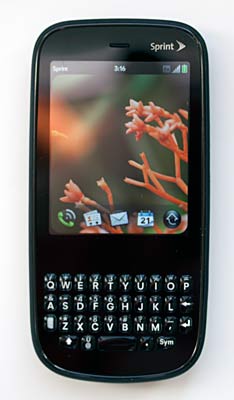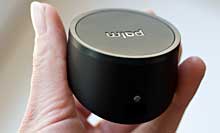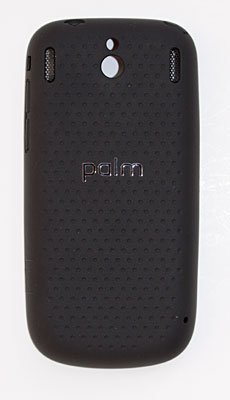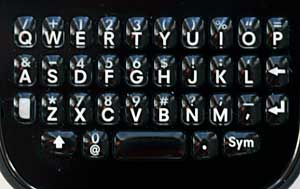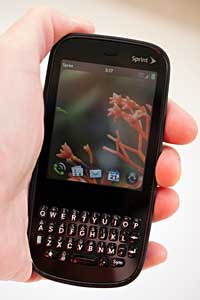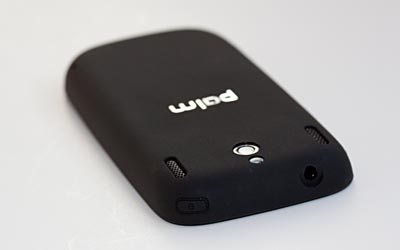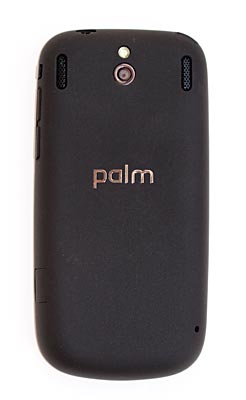
|
||||||||
The phone's front face is glossy and attractive. The back is curved and modern. It doesn't look like an expensive phone but it looks like a cool phone and is a good update from the Centro's basic form. There are hardware volume buttons and a ring silencer slider on the right and a power button up top. That's it for mechanical buttons. Like the Pre, the Centro has a touch sensitive control just below the display that lights up whenever it's available for use. This white bar handles most everything that an old-fashioned phone's d-pad and enter key would: moving back and forth between browser and application windows and returning to the desktop. Simple and easy. Need to wake up the phone? Briefly press the power button then slide the on-screen unlock icon. Also simple and standard among touch screen phones.
The Pixi's 320 x 400 pixel display is lower resolution than the Pre's (320 x 480) and more closely matches what you'd see on a solid feature phone. That's OK but the 2.63" capacitive LCD is too small for finger touch and multi-touch isn't the easiest to use with so little screen real estate. The Pixi's screen is bright but it doesn't look quite as sharp and colorful as the Pre's. Video Review Here's our 8 minute video review of the Palm Pixi:
Phone and Internet The Pixi is a dual band digital Sprint phone (they have the exclusive for now). It has EV-DO Rev. A for fast data with fallback to 1xRTT. Call quality is good with clear and full voice on both incoming and outgoing ends. Volume is good enough to make a call from a big box store and the phone doesn't transmit a lot of background noise. Reception is also good, with the Pixi pulling in a slightly stronger signal than average among Sprint phones. There's no voice dialing and no speed dial but it has smart dialing (type in a few characters of a contact's name to bring them up for dialing and texting).
Web browsing is good thanks to webOS' capable webkit browser (the iPhone also uses webkit). The display is too low resolution compared to today's smartphones like the Pre, Hero and Droid, but it's the affordable (less feature-rich) smartphone so don't expect it to keep up. That means more scrolling and zooming to view desktop layout web pages. That said, it's quite good and if you're upgrading from the Centro, you'll be floored because the Pixi's browser is that much better. Most full HTML sites render well, and Sprint's EV-DO. Rev. A supplies a fast connection to the web. Email is strong on webOS and the Pixi can handle MS Exchange, POP3 and IMAP email well. Palm's Synergy means that you can sync to multiple sources-- Facebook and multiple Exchange accounts for your contacts and not be overrun with duplicates. Very, very nice.
Performance The Palm Pixi has an impressive dual core Qualcomm CPU running at 600MHz (the other core handles modem functions and runs at 400MHz). There's also graphics hardware acceleration on board yet the Pixi feels slow compared to the Palm Pre. Granted the Pre uses a different CPU but the clock speeds are the same-- leaving us to wonder if Qualcomm's CPU is lacking or if the folks at Palm have some more bugs to squash and optimizations to create. Rumor has it that Palm will release an OS update for the Pixi in January 2010 that will speed up the smartphone. The Pixi isn't always slow, but it bogs down randomly and just long enough to convince you to tap or swipe a second time when you didn't really need to. That of course, leads to piling on an unwanted task that further slows down whatever it was you were actually trying to do in the first place. The Pixi isn't a pig, but it reminds us at times of laggy older Windows Mobile phones rather than the spritely Pre and iPhone.
Camera and GPS The Pixi is good for getting you where you need to go, and it can show you tempting places you didn't know about before, courtesy of Google Maps. Sprint Navigation is on board for spoken turn-by-turn directions too (Sprint Nav, powered by TeleNav is included with Sprint's Everything plans). The GPS worked well in our tests, keeping up with our location on the road and providing cogent directions. The camera on the other hand, is by no means impressive. It's only 2 megapixels-- which would have been exciting 4 years ago, but now puts it squarely at the bottom of the camera phone barrel. It takes OK photos by 2MP standards and the tiny LED flash helps little for dark shots. The camera doesn't shoot video (really). Conclusion The Palm Pixi is an affordable, fun and intuitive smartphone. We still like webOS quite a lot, though the Pixi's hardware doesn't show it off as well as the $50 more expensive Palm Pre. If you're upgrading from a Centro there's a lot to like, including the much more modern OS with multitasking, a good GPS, and support for Sprint's myriad services like Sprint TV and NFL Mobile. We're not in love with the keyboard, but we weren't a fan of the Centro's either. It's tiny and the keys are gummy bubble affairs that seem toy-like. The phone is good looking, feels great in hand and seems sturdy though the plastic front face may be prone to scratching. Now that apps are appearing on the Palm App Catalog, you can have fun downloading free and paid apps directly to the Pixi, and though the selection can't compete with iTunes and the Android Marketplace, it's a good start. The Pixi is prone to sluggishness despite the fast CPU, and we hope that Palm can fix this with a firmware update. Pro: Fresh, modern and intuitive OS. Looks good and feels good in the hand. Full suite of Sprint applications and services. Very good webkit web browser. Awesome cloud-syncing capabilities with MS Exchange, Facebook, Google and more. Con: Sluggish at times. Not a good choice for those who want USB syncing to desktop PIM applications like Outlook. No WiFi. Display is a bit small for capacitive multi-touch and the resolution is relatively low.
Websites: www.sprint.com, www.palm.com Price: $99 with a 2 year contract.
| ||||||||
